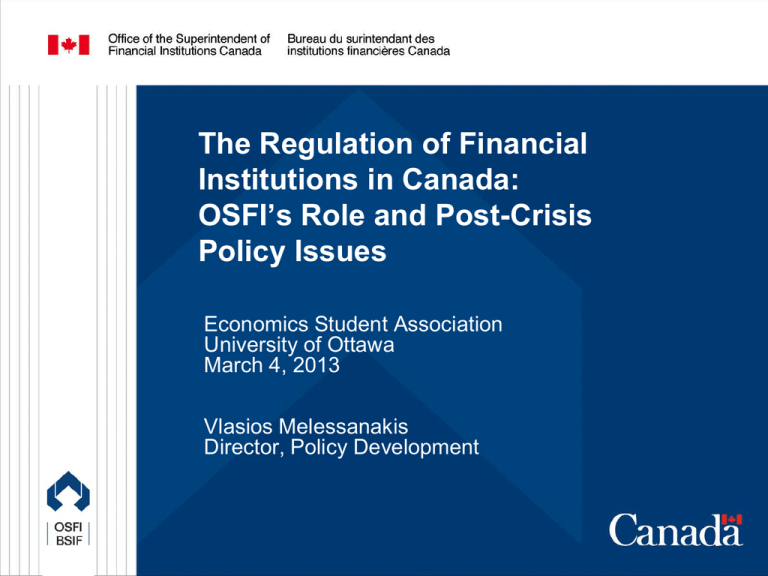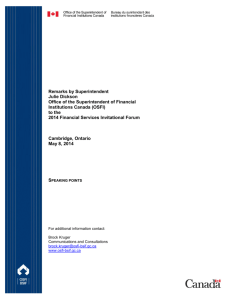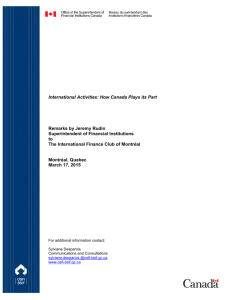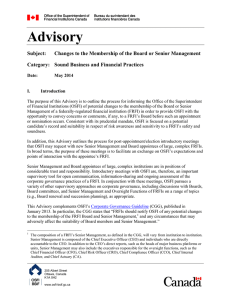March 4 2013 - Economics Students Association
advertisement

The Regulation of Financial Institutions in Canada: OSFI’s Role and Post-Crisis Policy Issues Economics Student Association University of Ottawa March 4, 2013 Vlasios Melessanakis Director, Policy Development Agenda • OSFI mandate, structure and approach • Post-crisis policy issues • Final thoughts 2 OSFI Mandate, Structure and Approach 3 OSFI Mandate • OSFI established in 1987 following two bank failures in Western Canada – Independent agency that reports to the Minister of Finance – Funded through assessments on the industry and a user-pay program for select services • Mandate to protect depositors and policyholders, and to contribute to public confidence in the Canadian financial system – Not market conduct 4 OSFI Organizational Structure • Approximately 600 employees in Ottawa, Toronto, Montreal and Vancouver Regulation Sector (rule-making, approvals, international) Supervision Sector (monitoring, assessing, intervening) Corporate Sector (human resources, finance, communications, IT) 5 Federally-Regulated Financial Institutions Financial Institutions Number Banks 76 Trust/loan companies 68 Insurance companies 264 Cooperative Credit/Retail Associations 7 Pension Plans 1,354 6 Regulatory and Supervisory Approach • Regulation – Legislation (Bank Act, etc.), guidance, advisories and rulings – Approvals (Superintendent and Ministerial) • OSFI Supervisory Framework – Early intervention supported by formal tools (prudential agreement, directive of compliance, capital order, etc.) – Risk-focussed, on a consolidated basis • OSFI/CDIC Guide to Intervention for deposittaking institutions – “Staging” system with escalating monitoring and interventions by OSFI and the Canada Deposit Insurance Corporation (CDIC) 7 Financial Institutions Supervisory Committee (FISC) • Chaired by the Superintendent of Financial Institutions • Other members: Bank of Canada Governor, Deputy Minister of Finance, CDIC Chair and Financial Consumer Agency of Canada (FCAC) Commissioner • Meets at least quarterly • Facilitates discussion and exchange of information related to the supervision of financial institutions – Critical mechanism for resolution/crisis situation • Final decisions rest with the respective agencies 8 Other Coordination Mechanisms • Senior Advisory Committee (SAC) – Chaired by Department of Finance – Discussion forum for broad financial sector policy issues (including macro-financial vulnerabilities) • Heads of Agencies Committee – Chaired by the Bank of Canada – Includes 4 provincial securities regulators (Ont., B.C., Que., Alberta) – Discussion forum for capital market developments • CDIC Board 9 International Organizations Standard-Setting Bodies • Basel Committee for Banking Supervision (BCBS) • International Association for Insurance Supervisors (IAIS) Coordinators/Others • Financial Stability Board (FSB) • Joint Forum on Financial Conglomerates • Senior Supervisors Group (SSG) • International Accounting Standards Board (IASB) 10 Post-Crisis Policy Issues 11 Global Financial Crisis (2008 – ) 12 Real Economy Effects – U.S. Employment 13 Key Financial Sector Policy Themes “We are committed to design and implement a system where we have the powers and tools to restructure or resolve all types of financial institutions in crisis, without taxpayers ultimately bearing the burden…” (G20, Toronto, June 2010) • Capital and liquidity requirements • Systemically-important banks • Mortgage underwriting • Shadow banking • Corporate governance 14 Aside: Banking vs. Insurance • A debate as to whether insurance should be targeted to the same degree as banking – The AIG failure was the result of its banking operations • BCBS far more advanced in their reforms relative to the IAIS • Nonetheless, the IAIS is bolstering its efforts for common insurance standards – Common Framework for the Supervision of Internationally-Active Insurance Groups (“ComFrame”) 15 Bank Capital Requirements • “Basel III” focus on core tier 1 capital (or common equity) Common equity (% of Risk-Weighted Assets) Minimum 4.5% Conservation buffer (cannot pay dividends and bonuses if below) 2.5% Systemic buffer 0-2.5% Counter-cyclical buffer 0-2.5% 16 Bank Capital Requirements (Cont.) • OSFI’s revised Capital Adequacy Requirements (CAR) Guideline published in December 2012 – In effect January 2013 • Canadian banks’ common equity capital has increased by 77%, or approximately $72 billion since the 2008 crisis • Already meet Basel III capital requirements six full years ahead of schedule 17 Bank Liquidity Requirements • Basel III creates first-ever international liquidity standards • Liquidity coverage ratio (LCR) – Under specified stress scenario, liquidity for a 30day survival period • Net stable funding ratio (NSFR) – Minimum requirements for longer-term, more stable funding sources 18 Systemically-Important Banks (SIBs) • Identification of SIBs – FSB has tasked BCBS to identify SIBs – 28 global SIBs identified in 2012 based on five criteria • Size • Interconnectedness • Substitutability/infrastructure • Cross-jurisdictional activity • Complexity – No Canadian banks… yet – Global SIBs vs. domestic SIBs 19 List of Global SIBs Bank of America Citigroup New York Mellon Goldman Sachs JP Morgan Chase Morgan Stanley Wells Fargo State Street Royal Bank of Scotland Standard Chartered Barclay’s HSBC BNP Paribas Groupe BPCE Societe Generale Credit Agricole Deutsche Bank Unicredit UBS Credit Suisse BBVA ING Santander Nordea Mitsubishi UFJ Mizuho Sumitomo Mitsui Bank of China 20 Regulatory and Supervisory Requirements for SIBs • Adequacy of capital (Basel III) – Systemic buffer applied to SIBs (1-2.5% CTE) • Supervisory intensity and effectiveness • Resolution of SIBs – FSB Key Attributes of Effective Resolution Regimes (July 2011) – Recovery and resolution plans (or “living wills”) – Bridge bank vs. bail-in as alternatives to bail-outs – Cross-jurisdictional cooperation 21 Mortgage Underwriting • Consensus that housing finance a common theme among banking crises • FSB thematic review (March 2011) • FSB Principles for Sound Residential Mortgage Underwriting (April 2012) • OSFI Guideline B-20 22 Housing Prices in Canada 23 Shadow Banking • Shadow banking defined as “credit intermediation involving entities and activities outside the regular banking system.” (FSB) – $27 trillion in 2002 to $60 trillion in 2007 • FSB report on Shadow Banking: Strengthening Oversight and Regulation in Oct. 2011 • Five work streams – Bank interactions with shadow banks – BCBS – Money market funds (MMFs) – IOSCO – Other shadow banking entities – FSB task force – Securitization – IOSCO – Securities lending and repos – FSB task force 24 Shadow Banking Flow Chart 25 Corporate Governance • Corporate governance lapses seen as contributor to banks taking excessive risks prior to the crisis • FSB Principles for Sound Compensation Practices released in 2009 – Bank bonuses should not provide incentives to take imprudent decisions • A plethora of reports on governance – UK Walker Report (2009) – BCBS Principles (2010) – SSG Report on Risk Appetite (2010) – G30 Report (2012) 26 Corporate Governance (Cont.) • The critical role of the Board of Directors – Independent oversight of strategy, controls, etc. – Competencies and skills • Risk governance – Risk appetite – Role of the Chief Risk Officer (CRO) – FSB thematic review in 2012/13 • OSFI Corporate Governance Guideline (2013) 27 Final Thoughts 28 A New Era… • “Too big to fail” has not been solved. Much work to be done • 50 years from now, we will be referring to this period in economic history in the same way that we now refer to the Great Depression – The scale, complexity and speed of the 2008 crisis – The flurry of international policy activity that has followed • Canada did a lot right, but it is important not to be complacent – This is a once-in-a-generation opportunity to holistically evaluate global banking standards and the domestic regulatory regime 29 Questions? 30











